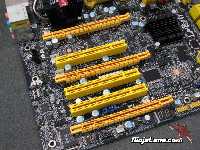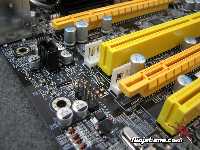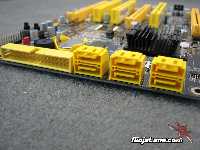After careful consideration I have decided to transfer all hardware review activities to a new domain. I purchased Hardwareasylum.com in 2012 and have been working hard to build a new and improved Ninjalane on that domain. If you are reading this you have reached one of the archived articles, news, projects and/or reviews that were left behind during the site migration.
Please update your bookmarks and be sure to visit the new and improved Ninjalane at Hardwareasylum.com
DFI LanParty DK 790FXB Motherboard Review
Author: Dennis Garcia
Published: Tuesday, May 19, 2009
Board Layout and Features
DFI has applied their standard PCIe / PCI configuration to the 790FXB with 3x (Gen 2) 16x PCIe graphics slots, and 3 standard PCI slots. You won't be able to run 4 independent graphics cards on this board but you can get a nice 3-way going or run cards in the following configurations.
- 2-way CrossFire at x16/x16 or x16/x4 bandwidth
- 3-way CrossFire at x16/x16/x4 bandwidth
The graphics slot configuration is dynamic and supports a variety of different situations. However the 3rd PCIe slot at the bottom of the board is running with x2 bandwidth by default. You will find the jumper block to enable the x4 bandwidth between the last PCIe and PCI slot.
On a side note we really like the "standard" expansion slot layout that DFI uses. The spacing gives you plenty of room for dual slot cooler video cards and still offers up standard PCI expansion slots with at least two of them being usable even with Crossfire enabled. The last PCIe slot would be perfect for a hardware raid card or external PhysX processor.
- 2-way CrossFire at x16/x16 or x16/x4 bandwidth
- 3-way CrossFire at x16/x16/x4 bandwidth
The graphics slot configuration is dynamic and supports a variety of different situations. However the 3rd PCIe slot at the bottom of the board is running with x2 bandwidth by default. You will find the jumper block to enable the x4 bandwidth between the last PCIe and PCI slot.
On a side note we really like the "standard" expansion slot layout that DFI uses. The spacing gives you plenty of room for dual slot cooler video cards and still offers up standard PCI expansion slots with at least two of them being usable even with Crossfire enabled. The last PCIe slot would be perfect for a hardware raid card or external PhysX processor.
High powered video cards require a little extra juice to ensure they are running properly. The 2 main video card slots both feature floppy style molex connectors for just that purpose.
You get a total of 6x SATA2 connectors and these are the locking kind. Sadly the included SATA cables feature no locks. I cannot speak for the rest of you but while I can agree that having the SATA cable lock is a good thing I cannot remember the last time a SATA cable fell out of a motherboard or SATA drive that was not somehow "encouraged" to do so.
You get a total of 6x SATA2 connectors and these are the locking kind. Sadly the included SATA cables feature no locks. I cannot speak for the rest of you but while I can agree that having the SATA cable lock is a good thing I cannot remember the last time a SATA cable fell out of a motherboard or SATA drive that was not somehow "encouraged" to do so.
For those of us that still use a floppy drive you will find the connector nearby but yet tucked down at the bottom of the motherboard so it is out of the way. There is really no reason for me to explain the importance that a standard 3.5" floppy drive holds in today's computing society, in fact every hardware enthusiast should have at least one stashed away for BIOS flashes and other emergency repair jobs. Flashing from a Flash drive is for suckas.
Here you will find the Debug LED along with the 6 extra USB connectors, EZ-power and reset buttons, CMOS battery and front panel connector. What you will not find here are the items normally reserved for the UT line, however their locations remain mapped out in the PCB.
Here you will find the Debug LED along with the 6 extra USB connectors, EZ-power and reset buttons, CMOS battery and front panel connector. What you will not find here are the items normally reserved for the UT line, however their locations remain mapped out in the PCB.





